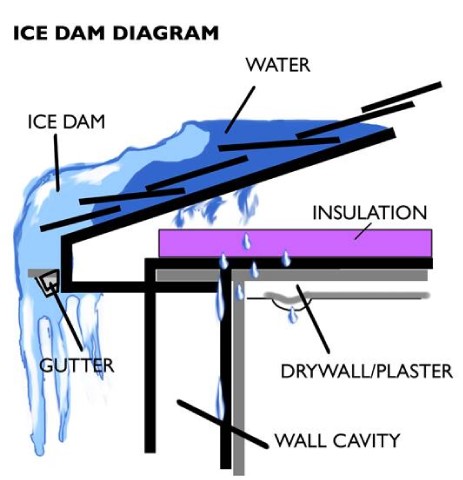Protecting Your Home from Icicles and Ice Dams During the Winter Months
Share Article:
One of the best things about living in a state with four seasons is the change in weather and the beauty that accompanies it, ranging from bright white snow to the green leaves of spring. But living in a state where temperatures drop below freezing has some downsides, too, including the risk of icicles and ice dams on a home during the winter months. Consider the following about what you need to know about icicles, ice dams, and how to protect your home when it’s cold outside.
What’s an Ice Dam?
Most homeowners are familiar with icicles that hang from the roof, posing a threat to those who pass underneath. But ice dams are a bit more confusing to understand – ice dams occur when water freezes at the edge of a home’s roofline,  growing big enough in size to prevent melting snow from properly draining. The result: water back up on the roof that gets under the shingles and leaks into the home – a potentially expensive and stressful disaster. You can usually recognize an ice dam by the characteristic icicles that hang from the roof. If you are a home buyer in search of a new home in the wintertime, be aware of the presence of icicles, which could spell trouble!
growing big enough in size to prevent melting snow from properly draining. The result: water back up on the roof that gets under the shingles and leaks into the home – a potentially expensive and stressful disaster. You can usually recognize an ice dam by the characteristic icicles that hang from the roof. If you are a home buyer in search of a new home in the wintertime, be aware of the presence of icicles, which could spell trouble!
How to Prevent Icicle and Ice Dam Formation
Luckily, there are a number of easy steps that you can take to reduce the risk that icicles or an ice dam will form on your roof, which could be extremely problematic. These include:
- Remove snow when possible. If you have a low-hanging roof that is accessible with a rake or a broom, remove as much snow from the edge of the roof as possible. This can help to prevent snow at the edge from freezing into ice.
- Clean your gutter before snow hits. One of the best ways to prevent an ice dam from forming is to get your gutter cleaned by a professional before snow and icy rain hit. If your gutter is filled with leaves and debris, these too can freeze, resulting in backup.
- Insulate your attic. Insulating your attic is smart for wintertime preparedness for two reasons: First, it helps to keep the inside of your house warm, reducing your energy expenses; second, insulating your attic will also help to prevent heat from escaping and warming the underside of your roof. When the underside of your roof is heated, the bottom layer of the snow will melt. Unfortunately, the snow towards the edge of the roof (which does not receive the same amount of heat as do higher areas of the roof) will stay frozen, resulting in a backup of water and the potential for ice dam damage.
- Apply ice melt. If you notice that ice is accumulating, leading to the potential of an ice dam, take action quickly by applying a calcium chloride ice melt, which will immediately get to work on melting ice and snow and allow for water to flow off the roof rather than leak into your home.
Keep your home healthy this winter.
Icicles and ice dams are much more common on older homes with poor insulation and ventilation. When you are building your dream home, Simplicity leads the industry with best practices and technology for attics and roofing to prevent against the formation of icicles and ice dams, no matter how cold it gets. Contact us today to learn more about building a new Simplicity home.
